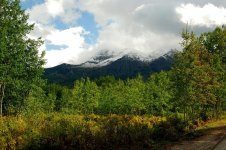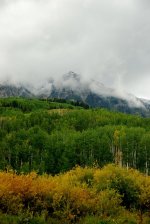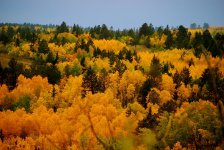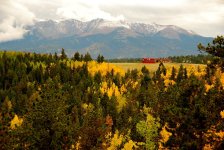csgaraglino
Senior Member
So I am heading out for a hike this weekend to shoot the fall colors here in Colorado. I have a plethora of lenses to bring as well as other gear. All said it would probably nearly 75 pounds if I took everything and the hike might last all of 15 minutes!
So time to trim the fat and scale down to a smaller backpack for the actual hike - but what to bring?
The elevation will average about 10,000 feet and there will be lots of tree, mountain ranges, lakes and waterfalls - with the slight chance of large game wildlife. I say slight, because this area is somewhat touristy and wildlife in the masses tends to stay deeper in the woods.
Looking at Garmin Basecamp I have mapped out 5 lakes and two waterfalls on 2 different routes from the trail head. This will make the hikes about 2 miles each and roughly 400+ vertical feet of climbing each.
The weather is going to be hit and miss. We are expecting a big cold front to come in tomorrow with rain/snow Friday leaving the ground damp for Saturday morning shoot. Meaning that Saturday morning could have fog, mist, sun, some or lots of clouds - then turning into a sully day and evening.
My intent is to hike one at dawn and the other at dusk.
I do have a smaller backpack that can hols a body & lens and an extra lens - along with some other gear and accessories.
I have the standard lenses, 14-24, 24-70, 70-200 and then a 60 macro, 85 1.8, and a 300mm with a 1.4x - I have my standard tripod with 55mm ball and a much smaller/lighter tripod that maxes out at 24". I have a slew of filters from polarizes to several ND and ND Grads.
Since I can only bring a body and 2 lenses - which to bring? Do I sacrifice weight vs functionality for tripods? What about optional accessories/gear?
Here are a few typical shots form other years of fall color here in my backyard - this hike will be in a completely different locations with lots of water - but you get the idea.




So time to trim the fat and scale down to a smaller backpack for the actual hike - but what to bring?
The elevation will average about 10,000 feet and there will be lots of tree, mountain ranges, lakes and waterfalls - with the slight chance of large game wildlife. I say slight, because this area is somewhat touristy and wildlife in the masses tends to stay deeper in the woods.
Looking at Garmin Basecamp I have mapped out 5 lakes and two waterfalls on 2 different routes from the trail head. This will make the hikes about 2 miles each and roughly 400+ vertical feet of climbing each.
The weather is going to be hit and miss. We are expecting a big cold front to come in tomorrow with rain/snow Friday leaving the ground damp for Saturday morning shoot. Meaning that Saturday morning could have fog, mist, sun, some or lots of clouds - then turning into a sully day and evening.
My intent is to hike one at dawn and the other at dusk.
I do have a smaller backpack that can hols a body & lens and an extra lens - along with some other gear and accessories.
I have the standard lenses, 14-24, 24-70, 70-200 and then a 60 macro, 85 1.8, and a 300mm with a 1.4x - I have my standard tripod with 55mm ball and a much smaller/lighter tripod that maxes out at 24". I have a slew of filters from polarizes to several ND and ND Grads.
Since I can only bring a body and 2 lenses - which to bring? Do I sacrifice weight vs functionality for tripods? What about optional accessories/gear?
Here are a few typical shots form other years of fall color here in my backyard - this hike will be in a completely different locations with lots of water - but you get the idea.




